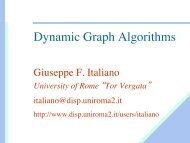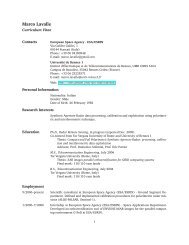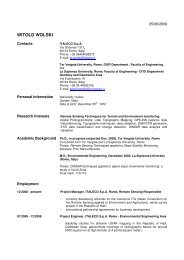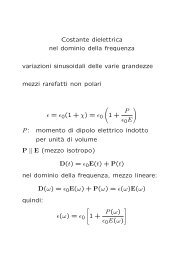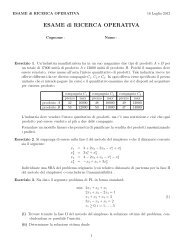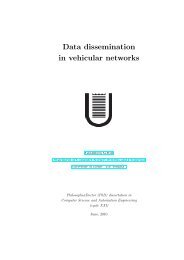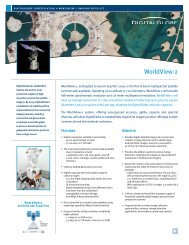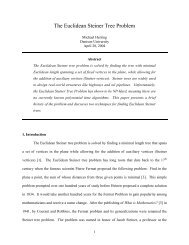TOR VERGATA UNIVERSITY UNSUPERVISED CLASSIFICATION ...
TOR VERGATA UNIVERSITY UNSUPERVISED CLASSIFICATION ...
TOR VERGATA UNIVERSITY UNSUPERVISED CLASSIFICATION ...
You also want an ePaper? Increase the reach of your titles
YUMPU automatically turns print PDFs into web optimized ePapers that Google loves.
2.2 Hyperspectral sensors<br />
Chapter 2 41<br />
Nowadays, hyperspectral sensors are increasing their importance in remote sensing<br />
studies. ESA Chris-Proba 11 and Hyperion 12 were the first satellite missions<br />
dedicated to this sensor. However, their spatial resolution (30 meters for Hyperion,<br />
from 18 to 30 for Chris-Proba) cannot be considered as ―Very High Resolution‖,<br />
therefore no useful for the purposes of the study.<br />
For this reason, it has been decided to use airborne hyperspectral sensors, which<br />
combines very high spatial resolution with several contiguous bands.<br />
2.2.1 AHS<br />
The Airborne Hyperspectral Scanner (AHS) is an imaging line-scanner radiometer,<br />
installed on a CASA-212 200 series aircraft owned by Spain's National Institute for<br />
Aerospace Technology (INTA) 13 .<br />
The AHS instrument (Fig. 2.5), with a whiskbroom linescanner, acquires images in<br />
80 spectral bands covering the visible and near infrared (VNIR), short wave<br />
infrared (SWIR), mid-infrared (MIR), and thermal infrared (TIR) spectral ranges<br />
(Table 1), having a digitisation accuracy of 12 bits.<br />
With its wide spectra, AHS has been used for several earth observation topics, as<br />
thermography [206] and agriculture [207].<br />
11<br />
ESA Chris Proba home page: http://earth.esa.int/missions/thirdpartymission/proba.html<br />
12<br />
Nasa Hyperion Instrument: http://eo1.gsfc.nasa.gov/Technology/Hyperion.html<br />
13<br />
The INTA AHS system<br />
http://bo.eufar.net/document/publi/124901161346543eefc58cf:SPIE_RS05_INTA_5978-56.pdf





